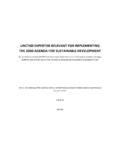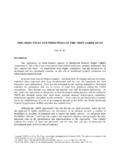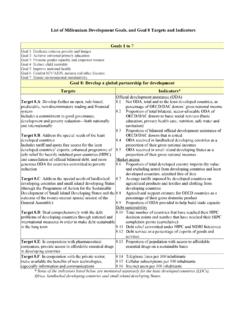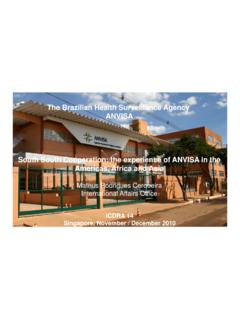Transcription of www.globalhealth - WHO
1 Trade NegotiationsSince 1947, the General Agreement on tariffs and Trade (GATT) and subsequent World Trade Organization (WTO) accords have facili-tated the negotiation of lower tariff rates among member In addition, bilateral agree-ments, such as the free trade agree-ment (FTA),7 regional trade agreements, and other trade agreements between groups of coun-tries have resulted in drug tariff reductions. Multilateral work continues on tariff reduc-tions in the Doha Round, the ongoing WTO negotiations on new trade rules and implemen-tation of the 2001 Doha Development Agenda ,8 Current negotiations are stalled, primar-ily because developed countries are reluctant to relinquish agricultural subsidies and developing countries are unwilling to reduce general import tariffs .
2 The stalled negotiations have delayed additional pharmaceutical tariff health and access to pharmaceuticals have achieved a special place in trade negotiations, as codified in GATT 1947 Article XX(b),9 the Pharmaceutical Tariff Elimination Agreement,10 and the Doha Therefore, the pub-lic health community has a key role to play in maintaining and advancing pharmaceutical trade negotiations. The ImpacT of TarIff aNd NoN-TarIff BarrIersoN access To esseNTIal drugs for The pooresT peoplepolIcy BrIefDespite an enormous global supply of pharmaceuticals, regular access to medicines has not been realized in much of the world. Drugs are widely available in only 28 percent of countries, with many factors, including pharmaceutical costs, affecting On a national health system level, pharmaceutical costs are the largest health expenditure after ,3 For individuals in developing countries, the price of essential medicines may be burdensome; these costs are usu-ally borne by developing countries are net importers of pharmaceutical products and many impose tar-iffs and non-tariff barriers (NTBs) on finished drugs, active pharmaceutical ingredients (APIs), and excipients (inactive substances that contain the active ingredients).
3 tariffs and NTBs con-tribute to pharmaceutical costs by increasing the final price of essential drugs, limiting access for the poorest people. Although some developing countries ( , China, India and Brazil) have established pharmaceutical industries, they continue to import some , 5 This policy brief describes tariffs and NTBs and the relationship between these trade-related barriers and access to essential drugs. It explores current efforts to reduce these barriers and proposes policy and advocacy recommendations. are customs duties or taxes imposed by governments when goods enter a country. They are simple rates applied to the value of imported goods. For example, when Drug A has a factory price of $ and enters a country that imposes a 10 percent tariff, the cost of Drug A is now $ with $ going to the country.
4 Non-tariff barriers are any trade measures (other than tariffs ) imposed by governments to restrict or prohibit imports. NTBs take numerous forms, such as preferences for domestic bidders in government procure-ment or complex language requirements on packaging. Both tariffs and NTB rules and regula-tions must be managed before a product can enter a country. These measures may be designed to promote the development of locally produced goods, so that they have an advantage over imported ones. tariffs and NTBs are the subject of attention in international organizations, such as the World Trade Organization (WTO), the World Health Organization (WHO), and the United Nations Conference on Trade and Development (UNCTAD).
5 TariffsAlthough countries may impose tariffs to protect local industry, raise revenue, or retaliate against trade rule violations by another country, the global trend has been to reduce or eliminate tariffs . The goal of lower tariffs is to stimulate trade, competition, and price Yet, some local industries may see this scenario as non-beneficial, as lower tariffs force them to compete with foreign producers who may offer better quality or lower priced goods. From the health sector perspective, minimizing tariffs may increase purchasing power for the public and private sectors, so long as sales tax and other drug price compo-nents are controlled. Optimally, this will lead to greater availability of essential medicines for the health system.
6 There are strong arguments in favor of tariff removal on essential pharmaceutical products, as revenue from these tariffs is low and imposing tariffs on APIs and excipients used by local producers ultimately increases the price of their examining the effect of tariff rates on access to essential pharmaceutical products and revenue indicate that: 2, 12 About 39 percent of countries do not impose tariffs on finished pharmaceuticals. Of countries that do apply tar-iffs, 76 percent impose rates of less than 10 percent; the overall mean rate is nearly 5 , 12 While tariffs on all imports can represent up to one-third of all taxes, pharmaceutical tariffs generate less than percent of gross domestic product in 92 percent of ,13 Revenue losses from tariff reductions can be offset by economic gains generated by a healthier population.
7 Considering the impact of other price factors, the extent to which tariffs are a barrier to access is typically modest and should not be over Each component should be monitored to avoid any negative impact on drug 1. Example of non-tariff price component pro-portions for an imported drug in Kenya15 tariffs are regressive taxes, which disproportionately fall on the poor. Few developing countries apply their highest tariff rates; occasional rate increases occur despite potential decreases in access to essential Lack of comprehensive global data complicates efforts to calculate tariff rates that are determined by WTO accords, more than 300 other trade agreements, and 930 tariff schemes applied by 132 countries.
8 The 2007 World Tariff Profiles aggregates key data bases and should alle-viate the data Barriers While tariffs have been reduced, NTBs have increased Trade restrictions and controls asserted in a non-discriminatory manner are permissible if necessary to protect public WTO documents clarify which trade restrictions and controls are permissible, such as border measures to prevent the inflow of counterfeit and pirated Ensuring that non-tariff measures do not become non-tariff barriers is critical, as NTBs reduce the quantity and variety of products entering a country creating shortages of essential drugs and medical sup-plies. Reducing NTBs will facilitate product approvals and decrease costs, thereby increasing the flow of needed medications to the can take many different forms and work is needed to identify and classify those that affect access to essential medications.
9 Given the variety of NTBs and lack of a comprehensive and uniform reference system, analysis of NTB data is complex. Formally defining NTBs, develop-ing a protocol for collecting and disseminating data, and improving the Trade Analysis and Information System database will be undertaken by the Group of Eminent Persons on NTBs (GNTB), formed by 2sepTemBer 2007drug price components include: National pricing policies Market size Degree of competition Charges for port of entry clearance and freight Pre-shipment inspection requirements Pharmacy board fees Local drug registration Importer s margin Wholesaler and retailer mark-ups Non-tariff barriersretailer's mark-up36%wholesaler'smark-up16%importer 's mark-up32%importerdeclaration fee3%port and clearancecharges13%Because of their diversity and complexity, NTBs can complicate the efforts of both businesses and nonprofit organizations trying to import pharmaceutical products into a country.
10 Information on procurement processes, import rules, and drug registration is hard to find for most developing countries it is not electronically available, is not comprehensive, and may not be translated into the producer s language. Hidden costs in the process of drug importation may take the form of:12 Tedious and time-consuming banking procedures, par-ticularly for remittance of foreign exchange; Burdensome import approval procedures that add as much as US$7,000 and 18 36 months per product;17 Inflated charges and additional handling fees, even on donated products; Lengthy approval by more than one regulatory body ( , by both the drug registration authority and the health insurance body).18 harmonizing the standardsFor WTO members, two key agreements set standards on trade measures: Sanitary and Phytosanitary Measures (SPS) addresses food safety and animal and plant health standards, and the Technical Barriers to Trade (TBT) addresses technical measures, such as testing require-ments.
















